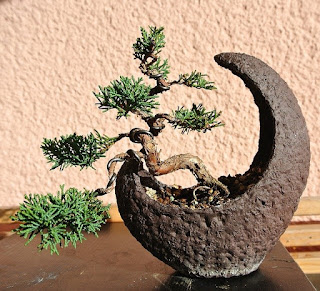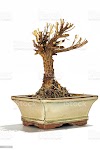Bonsai tree
Bonsai is basically a condition of any plant in which plants kept in the shape of small trees with stunting their growth. Any tree can be made into a bonsai. In any case, a couple of rules should be followed. The tree ought to have branches. One can't make a bonsai with a coconut tree. The leaves of the tree ought to be little. It will look odd on the off chance that one makes a one-foot tree and there are just 3 or 4 huge leaves.
Bonsai has two forms of expression:
stump bonsai
landscape bonsai.
landscape bonsai.
The former is mainly the art of cultivating tree species, while the latter is mainly an art embodied in a variety of materials. Therefore, bonsai is not only a tree but also other forms of expression, such as stone.
There are many options for the trees in bonsai, which can be planted and shaped in different forms, all determined by the grower. More than a thousand years ago, Japanese artisans developed bonsai art into an art form that expresses meditation and personal reflection.
There are five types of bonsai plants. There are "Songbashi", "Miscellaneous wood", "Flower thing", "Real thing" and "Grass thing". Many of these are primarily native to East Asia.WHICH PLANTS CAN BE BONSAI
Some are born in Japan, the Korean Peninsula, and China, and the climate in Japan is appropriate for the environment in which bonsai is made. Knowing what kind of background each species has been tailored to will enhance the way you enjoy bonsai.
However, in recent years, as bonsai has spread all over the world, plants other than the five types mentioned above have appeared. For example, tropical trees such as bougainvillea and hibiscus are planted as bonsai in Southeast Asia.
Let's look at the five main types of bonsai in order.
First of all, Matsukashiwa is a general term for conifers including pine, cedar, cypress, hinoki, shinpak, pine, yew, etc.
This is the most well-known type of bonsai. The feature is that it is durable and easy for beginners to raise. Since it is evergreen, you can enjoy green all year round. Above all, forest pine is characterized by a solid appearance, and if you make shari and jin well, you will get more atmosphere.
Shari and god are stated in which branches and trunks have withered, bark has been stripped, and woody parts have been exposed. It is called a god if it occurs on a branch, and a shari if it occurs on a trunk.
"Miscellaneous wood" refers to woody plants that look into Matsukashiwa. There are many types and many deciduous trees. Most of the long history originates in Japan and China.
Unlike conifers, you cannot see green all year round, but you can enjoy the changing seasons. The spring sprouts, summer-fresh greenery, autumn leaves, and winter fallen leaves of the bonsai you make will be especially impressive. Maple trees are also included in the miscellaneous trees, and in the fall you can see the bright red leaves in small pots.
"Flower thing" "real thing" aims at appreciating flowers and fruit mainly. The type is divided into "flower" and "real", but there are many bonsai that can enjoy both flowers and fruits.
Unlike pine trees and miscellaneous trees, flowering and fruiting are important points, so there are many differences in care. We perform flower removal and fruit picking and perform pruning depended on all small trees bonsai?
You may encounter many other small trees in your life, but not all small trees are bonsai. Bonsai tree has its own characteristics, and it must be well taken care of by people in order to be reflected.
First, the bonsai tree is unique and can reflect different aesthetic designs. Second, it will be placed in an appropriate position and integrated with other landscapes to reflect the artistic effect. These are the distinctive aspects of the bonsai tree.ding on the kind. The most difficult kind to keep beautiful.
"Grass" refers to herbaceous plants. Even beginners can grow easily and quickly. In addition, there are many unexpected pleasures, such as plants that die after blooming and plants that you don't remember appearing in the pots. When a seed is transported from somewhere and an unplanted plant comes out of the pot, it is called a "dive."
When you limit the space for plants to grow, the plants make adjustments.
first, placing a cut tree in a flower pot can effectively limit the growth space of the roots. Next, you need to carefully take care of this tree for a long time, and guide its growth through careful trimming and shaping to form you. What you want.
There are about 160 varieties of stump trees currently used, but if you want a perennial potted tree trunk, small leaves or needles are the first choices for bonsai trees, because these tree species have the largest size and characteristics Experience the look you want.
Finally, when the tree reached its optimal size, it was carefully transplanted into the display basin and left there.
The bonsai tree has begun to take shape. If you want to perfectly reflect your artistic aesthetic, long-term care is the key. The cultivation of bonsai reflects the value of the cultivator's fine work and the self-discipline of taking care of the plants. The quality of a bonsai is also directly judged by its appearance, which requires the cultivator to invest a lot of time and energy to reflect. ,








0 Comments
plz do not any spam link in the comment box.